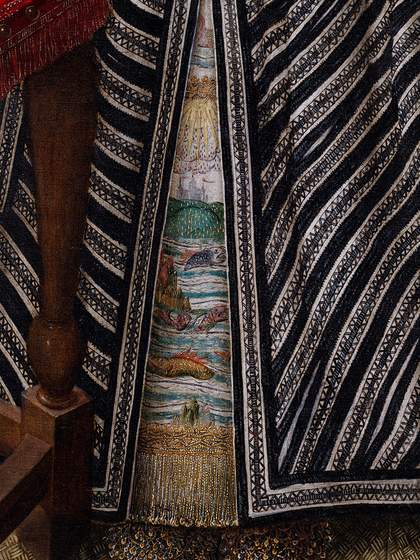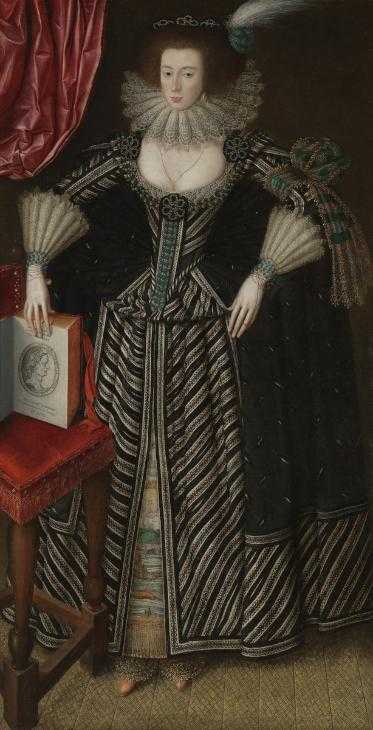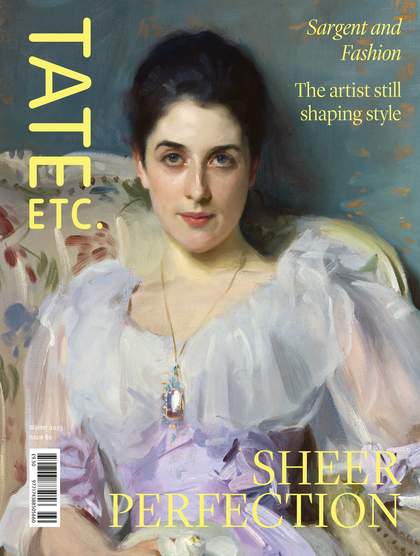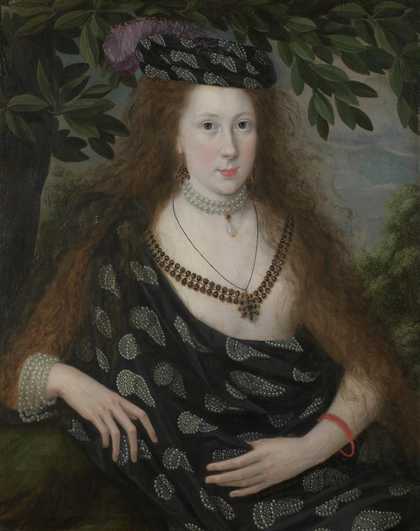
In Shekhar Kapur’s 1998 biopic of Elizabeth I, an assassination attempt is thwarted when one of the Queen’s maids of honour surreptitiously borrows a gown from her collection. She drops dead during a midnight tryst, revealing that the dress had been poisoned. This striking combination of fashion and biological warfare was invented for dramatic effect, but it’s known that Elizabeth I did give pieces of her clothing to women close to her. The petticoat worn by Mary Edmondes in this portrait may be one such item.
Interrupting the neat lines of Edmondes’s ensemble, like curtains parting on a theatre stage, a slice of the elaborately decorated petticoat can be seen beneath the big top of the farthingale. It’s just enough to discern a sea of strange creatures swimming under a dazzling celestial sky. This glimpsed scene conveys wealth and status (the luxury of a design that no one else will see) normally reserved for the upper echelons of Elizabethan society.
The ambiguities surrounding this petticoat, and indeed almost all clothing from so far back in history – long turned to dust and immortalised only through art – adds to the mystique. Fashion folklore loves to swirl around royal dress: the late fashion designer Alexander McQueen often repeated an anecdote about his time working on Savile Row, when he inscribed an unmentionable slogan inside a jacket made for future King Charles (colleagues at the tailors deemed it apocryphal, but it certainly makes for a good story).

Unknown artist, Britain
Portrait of a Lady, probably Mrs Clement Edmondes (c.1605–10)
Tate
The argument that the petticoat once belonged to Elizabeth I is supported by the fact that Edmondes was attendant to Lady Stafford, who is sometimes described as Elizabeth I’s Mistress of the Robes. And its lavish design – probably taken from woodcuts in natural history and emblem books – closely resembles the motifs depicted in the famous Hardwick portrait of Elizabeth I, in which the Queen wears an underskirt extravagantly embroidered with various flowers and sea monsters (later appropriated by fellow British icon Vivienne Westwood for her Autumn/Winter 1997 collection ‘Five Centuries Ago’). Worn by a figure such as Elizabeth I, whose body and clothing came to represent much more than flesh and fabric, designs such as these seem symbolically significant – we posit what she was communicating about power or femininity or England itself.
But on Mary Edmondes, the petticoat speaks to the personal histories woven into our garments – like an heirloom bracelet gifted by a grandparent on a birthday, a borrowed blouse, a much-loved leather jacket listed on eBay with a detailed backstory. It can be read as something subtler and sweeter: a hand-me-down.
Portrait of a Lady, probably Mrs Clement Edmondes was bequeathed by Drue Heinz DBE 2018 and is currently on display at Tate Britain.
Liberty McAnena is a London-based researcher and writer with an interest in fashion history.



